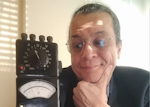This article is part of the TechXchange: Oscillations, Timing and Synchronization.
One can make the argument that man is the only animal aware of time. Yes, animals do react to the passage of time and the change of seasons, but while they may have memory, most agree they have no real foresight. We, on the other hand, not only use time to document the past and plan for the future, we use time as a tool in the present.
Time is an underappreciated aspect of reality whose importance to society cannot be understated. Timekeeping is so important to the modern world that if somehow clock systems went akilter, society would collapse in days.
One can tell timekeeping is essential in this respect: Atomic-clock time is a commodity distributed free to the public, as ubiquitous and relied upon as power. In fact, the first nationally available timekeeping tool was the power cycle of the AC electricity distributed throughout the power grid. Almost every electric clock pre-quartz used the 60-cycle sine wave as its timekeeping reference, and many still do today in legacy designs.
Time Over Time
There are several reasons to use time, and they evolved along with society. An agrarian culture only needed to know the start of planting and harvest, and knowing the time of day wasn’t as important as using the sunshine while it lasted. Once business and commerce began to develop into a real community, the need arose to coordinate activities during the day to ensure all needed participants were present. Precision wasn’t that important yet, and many of the first clocks in town squares only had one hand.
The real impetus to accurate and precise timekeeping evolution is war, and its related supporting pursuits like navigation and battle coordination. Sn excellent novel called “Longitude” (also made into a video series) details how the British first developed accurate timepieces that could be taken on a ship. The reason you need accurate time on a ship at sea is that longitude is an imaginary delineation, as there's no East or West Pole on a globe.
To know how far East or West you are, you need to know how much of a time offset exists between the ship and home base. Once the British had good clocks, they proceeded to conquer the world with them.
WWI brought timekeeping to a new high (or low), using clocks on the battlefield to coordinate artillery bombardments and the related infantry charge they were supporting. That’s why nobody wears pocket watches after 1920—WWI killed the pocket watch because you can’t fight a war while digging in your pockets for the time (Fig. 1).
Once time got serious, people got serious with time. Today, militaries around the world issue soldiers wristwatches to ensure they have an accurate time reference in the field.
The core technologies of timekeeping and horology hadn’t changed much over the 200 or so years between the first clocks and the 1950s, when things began to change with electronic timekeeping.
The first true electronic clock was the Bulova Accutron, a watch that used an electronic circuit to stimulate a tuning fork, whose resonances ran the movement. At 180 Hz, it was the most accurate clock at the time not using atoms as a reference. It went up into space both in the dashboards of the spacecraft as well as on the wrists of the astronauts (Fig. 2).
The Quartz Wars and the Advent of Digitally Controlled Time
Although historic and groundbreaking, the electromechanical Accutron was merely a harbinger of the timekeeping technology to come. On Christmas Day in 1969, Seiko released the first commercial quartz wristwatch. Driven by a step motor, the Quartz Astron 35SQ brought commercial-grade timekeeping to everyone’s wrist.
Seiko was already making quartz clocks for broadcasting companies at the time, but they were as big as a small refrigerator. The miniature quartz clock wasn’t just important for wristwatches, it opened up a new world of embedded timekeeping applications.
On the heels of quartz timekeeping came timing devices like the 555 timer chip, designed in 1971 by Hans Camenzind of Signetics. Versions of the 555 timer have come from a myriad number of semiconductor manufacturers, including Avago, Exar, Fairchild, Intersil, Maxim, NXP, STMicroelectronics, and Texas Instruments.
Timekeeping as a space-based infrastructure commodity followed soon after with the GPS project, launched by the U.S. Department of Defense in 1973. The first prototype spacecraft went up in 1978, and the full constellation of 24 satellites became operational in 1993. Today that time signal is not only used for navigation and positioning, it's also the backbone timing infrastructure of the modern world. Here’s a video from my hobby channel Talking Timepieces that explains how your cell phone knows what time it is:
Time Will Tell
Core timekeeping technology has not remained stagnant, and it's still developing in interesting ways. For example, silicon resonators have emerged as a viable alternative to quartz-crystal oscillators. SiTime recently released the SiT5543, part of its Endura family of MEMS ruggedized Super-TCXOs. It features a ±5-ppb frequency stability over a temperature range from –40 to 95°C (Fig. 3) and lower power consumption in a package 40% smaller than a legacy oven-controlled quartz oscillator (OCXO). Such high levels of accuracy in a rugged device bring even more precision into time-related embedded applications.
The technology behind atomic clocks, the gold standard of timekeeping, hasn’t been dormant either. Today you can buy a variety of atomic clocks for almost any application. For example, AccuBeat’s latest multifunctional Rubidium Frequency Standard AR133 family of products are among the smallest atomic standards available (Fig. 4).
The family has a long-term accuracy and stability of 100,000,000,000th of a second per month, based on the quantum transition in a rubidium atom. The clock has a high-performance crystal oscillator locked to it, an embedded microprocessor, and a proprietary algorithm to optimize performance.
One day, atomic clocks will be small enough to deploy in almost any embedded application, providing a significant level of accuracy and precision to any time-based need. This is important because our need for increased time precision is driven by the advances in communication, automation, and navigation technology. Time is, and will continue to be, one of the most important aspects of your design, and it's one of the most critical factors in optimizing performance in almost any system.
Read more articles in the TechXchange: Oscillations, Timing and Synchronization.





